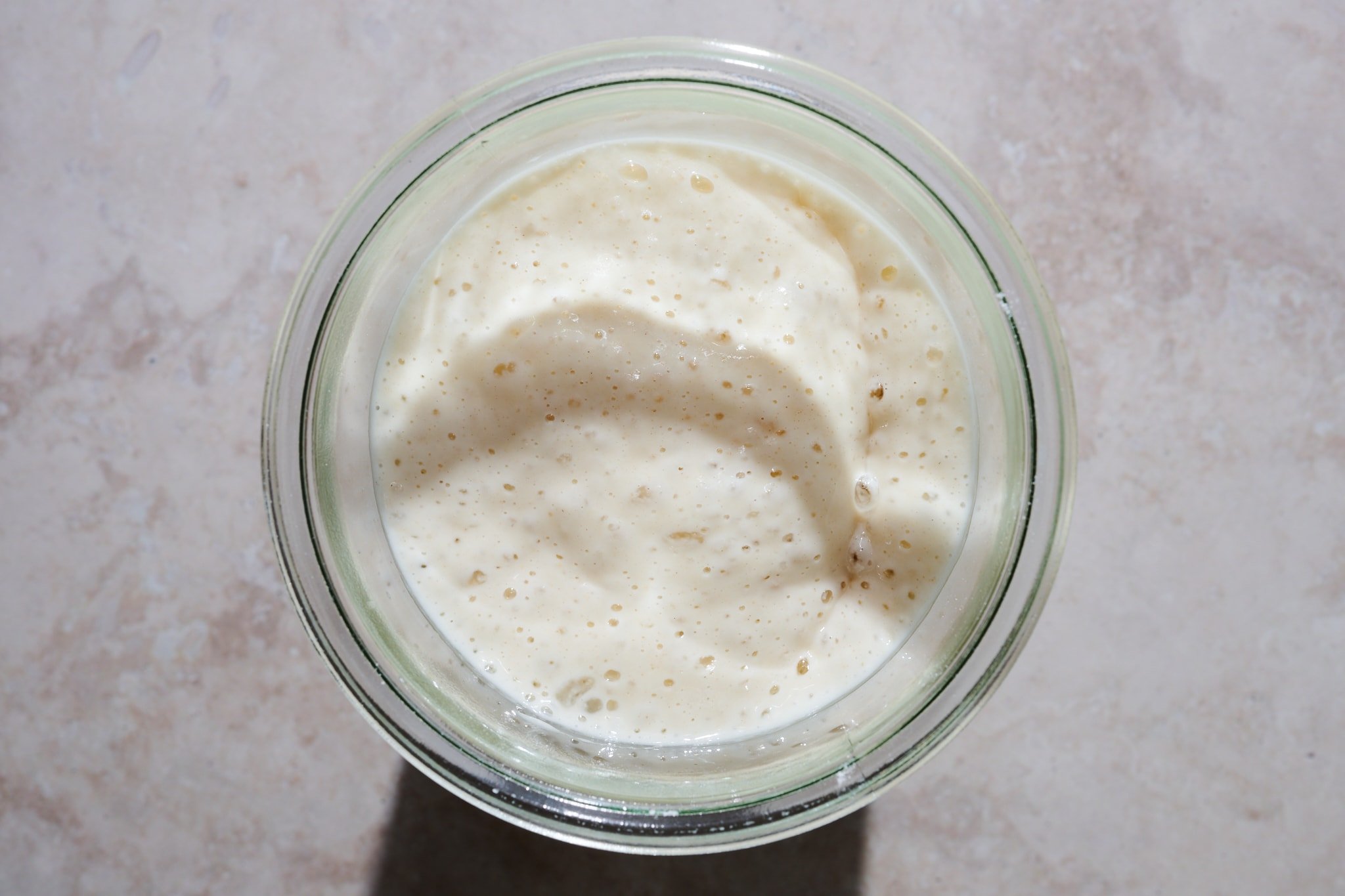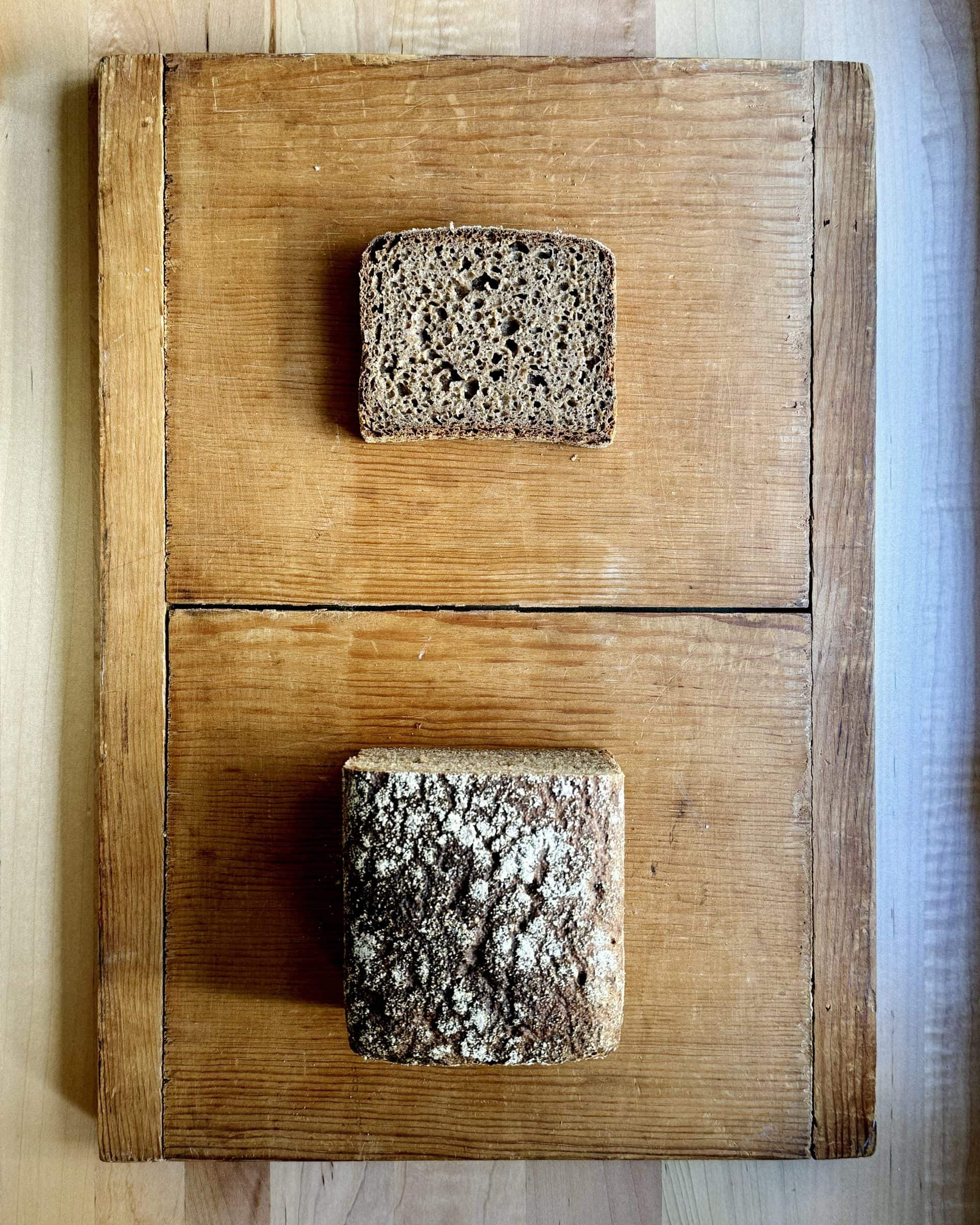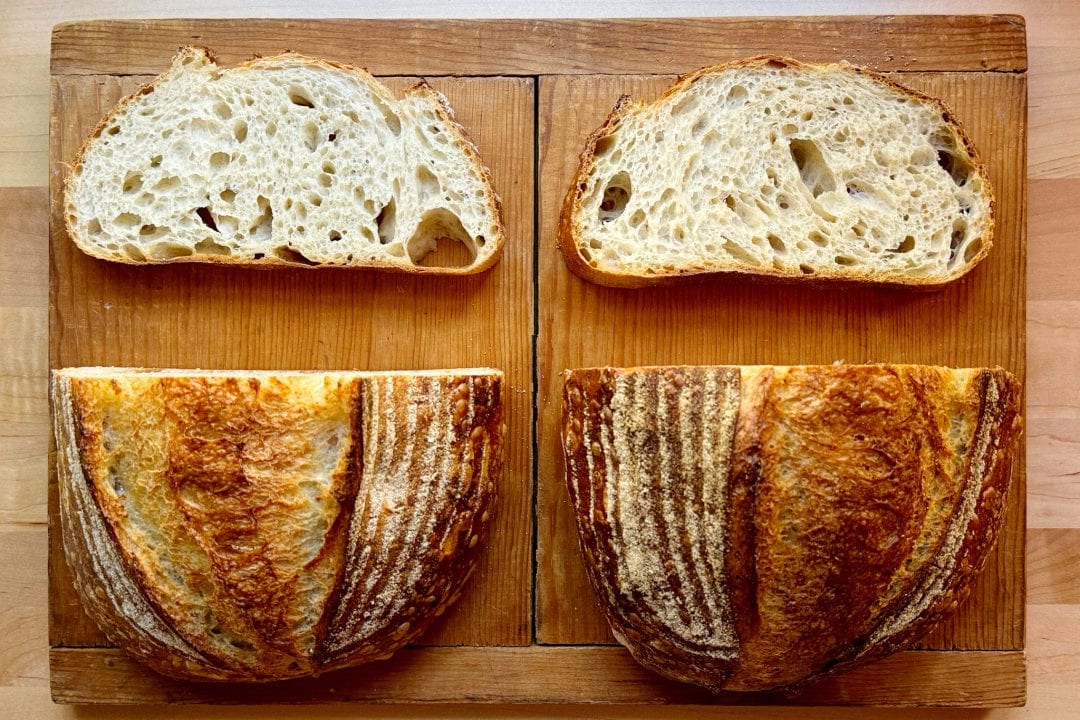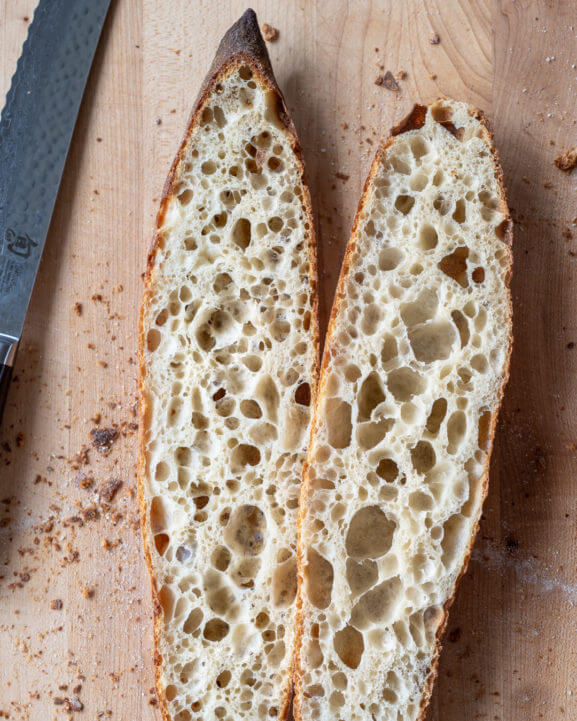With this first post, we welcome Andrew Janjigian to The Perfect Loaf. Andrew is a long-time bread baker, baking teacher, recipe developer, writer and photographer who writes a bi-weekly newsletter about all things bread and grain called Wordloaf, and also happens to be working on his first bread cookbook. Welcome!
A quick note from Maurizio. While this post by Andrew is meant to highlight the usefulness of commercial yeast in baking and hybrid doughs, The Perfect Loaf remains dedicated to sourdough bread baking. Without further ado, let’s dive in.
This might be a somewhat controversial topic for The Perfect Loaf, a website devoted to all things sourdough, but I’d like to dispel the notion that sourdough (and the wild yeast it contains) and commercial yeast cannot go hand in hand. Sometimes. In fact, there is actually a long tradition among professional bakers of adding small amounts of commercial yeast (sold in different categories known as “active dry,” “instant,” and “fresh” or “cake” yeast) to sourdough breads to promote good oven spring—a hybrid dough. The addition of yeast can also change the texture, flavor, and keeping qualities of the bread—for better, or worse. You might never have the need or desire to add yeast to your sourdough bakes, but the practice is worth knowing about just the same.
All of which means that adding commercial yeast to a sourdough fermentation is not an unnatural, alien practice.
Sourdough fermentations work via the synergy between two sets of organisms, yeasts and lactic acid bacteria, both of which consume simple sugars that are derived from the starches in the flour. The yeasts mainly make the carbon dioxide that gives bread its volume (along with ethanol and some flavor compounds), where the bacteria mainly make acids, which provide the bread’s signature tang (though they do produce small amounts of carbon dioxide under certain conditions).

There are many different species and strains of both yeasts and lactic acid bacteria in any one sourdough starter, and each starter likely contains a unique combination and ratio of different organisms. But one of the most common and abundant yeasts found in sourdough starters is Saccharomyces cerevisiae, aka “brewers” yeast. And while the strain of S. cerevisiae in sourdoughs is different than the one used to make commercial yeast, they are both the same species. And though the sourdough-specific strains of S. cerevisiae are much better adapted for the high-acid environment they exist in, the strains in commercial yeast can still thrive in the presence of acids, at least for the short durations of a dough's fermentation.
All of which means that adding commercial yeast to a sourdough fermentation is not an unnatural, alien practice. In fact, in France, where bread baking is a highly regulated industry, bakers are legally allowed to add up to 0.2% commercial yeast and still call the bread a sourdough.
Sourdough yeasts can of course produce all the carbon dioxide needed to give bread loft; still, there are numerous practices bakers use to increase that yeast activity in a purely sourdough culture. To name a few: Regular feeding of the sourdough at room temperature; multiple, rapid levain builds (including the practice known as a “booster” levain, where a high ratio of starter is added to a small amount of flour for a short, warm fermentation just prior to its use in a dough); or reduced levain hydrations. Adding commercial yeast to sourdoughs is just another way to increase the overall density of yeast in the dough to goose fermentation, and can be a useful tool for any baker when used judiciously.
Let’s explore the reasons a baker might choose to add commercial yeast to a sourdough bake.
Benefits to Adding Commercial Yeast to Sourdough Bread
Increased volume
Since yeast makes carbon dioxide, adding a small amount of commercial yeast to a sourdough can provide extra volume in the resulting bread, particularly in the case of breads that are otherwise resistant to springing on their own. My baker friend Jess Porter mentioned that at a place she used to work they added yeast to their cranberry-walnut bread, to overcome the negative effects on the crumb structure as a result of the extra weight of the fruit and nuts.

It’s also a common practice to add yeast to 100%-rye sourdough breads. Rye flour does contain gluten-forming proteins, but it doesn't form gluten networks like wheat flour does, which is why 100%-rye flour loaves are dense and close-textured. Nevertheless, the yeasts in the sourdough culture do serve to open up the crumb of rye breads as much as possible—without them, rye breads would be sticky bricks. Adding commercial yeast to a rye dough can help guarantee that the bread is dense, but not too dense.
A baker might also use commercial yeast—either fresh “cake” yeast, or instant—in their sourdoughs not to increase volume, but simply to guarantee the desired volume, despite the ups-and-downs a starter can go through from day to day and season to season. Sometimes a starter is firing on all cylinders, and at other times it might be a little sluggish, whether out of neglect or colder temperatures in the bakery during winter months. Adding yeast to a dough when a starter is not at peak activity can provide a degree of loft insurance, ensuring the loaves spring the way a baker expects them to. (Case in point: If you are working with a newly-created sourdough starter that isn't at peak strength yet—if the internal crumb is tight or the loaf does not spring sufficiently—you might want to add a little yeast to your doughs until it is, to guarantee an open crumb.)
More rapid and consistent fermentation
Adding yeast to a sourdough will also increase the rate of fermentation in the dough, relative to one without it. This can be especially useful in a bakery, where timing is everything. And again, it can provide consistency when a starter or a dough is sluggish, whether through temporary weakness or colder ambient temperatures (and we all know how important temperature is in baking). The increase in fermentation rate is dependent upon the amount of yeast used, of course.
A change in the texture, flavor, and other characteristics of the bread
Increasing the yeast activity in a sourdough through the addition of of commercial yeast has definite effects on the qualities of the resulting loaves, especially when it is used in high percentages. Many of the signature characteristics of sourdough bread come from lactic acid bacterial fermentation on the dough, mainly due to the production of lactic and acetic acid. When the balance is shifted in favor of yeast fermentation (through the addition of commercial yeast, even as little as 0.5%, relative to the total flour weight), lactic acid bacterial activity is dampened, and fewer acids will have formed by the time the dough is ready to bake. This can be a good or bad thing, depending upon what a baker is aiming for.
Fewer acids mean a less sour loaf, obviously—adding yeast can give a milder flavor profile to a sourdough, while still leaving it with some of the tang that only sourdough can provide. But the acids in sourdough also have a strong effect on the texture of a loaf too. Acids strengthen gluten networks, which is why sourdoughs—all else being equal—have a chewier crust and crumb than yeast-raised breads. Adding yeast to a sourdough can result in a lighter, more tender crumb and a crisper crust than the same loaf without it.
Now I like the texture of a crusty, chewy sourdough loaf most of the time, but there are instances where I find this effect especially useful. For example, I much prefer the texture of a sourdough baguette with a small amount of added yeast to one without it—I want my baguettes to be as light and crisp as possible, and commercial yeast helps guarantee this, while still allowing for some of the complexity of flavor that sourdough provides. Ditto flatbreads like focaccia and pita. I find all-sourdough pizza crusts a little too chewy; adding small amounts of yeast keeps them light, tender, and crisp, along with the extra depth of flavor that sourdough supplies.
…I tend to favor using yeast in breads not meant to last long, (again) like baguettes, flatbreads, and pizza.
Maybe the most significant effect of adding yeast to a sourdough is how it changes the bread’s keeping qualities. The reason why sourdough breads keep so much longer than most yeasted ones is also thanks to the acids in the loaf. With fewer acids, a loaf will tend to stale much more rapidly. This effect can be avoided by using a minimal amount of yeast, but it is something to be aware of, especially if you like your loaves to stay soft and moist as long as possible. For this reason, I tend to favor using yeast in breads not meant to last long, (again) like baguettes, flatbreads, and pizza.
Hybrid Dough: How to Add Yeast to Your Sourdough Bread
I've been adding yeast to some of my sourdough formulas for a long time now, but I ran some experiments recently to better understand the practice. Most bakers recommend a maximum of 0.2% fresh yeast—or 0.07% instant yeast, the sort most home bakers will have access to—relative to total flour weight, and I found those numbers to be a reliable guideline. This is a vanishingly small amount of yeast: For Maurizio's Beginner’s Sourdough Bread, one of the recipes I used in my testing, the amount comes to 0.5g instant yeast. (It helps to have an accurate gram scale when working with quantities this small, but in a pinch that amounts to slightly less than 1/8 teaspoon.)
When added at that rate, I found the dough to proof only slightly faster than without it; it was ready for shaping about 30 minutes ahead of the control. The resulting loaves had excellent oven spring and similar keeping qualities to the control, though with a slightly finer crumb, especially between the larger alveoli, and their flavor was a tad less sour. So I think 0.07% instant yeast is a good baseline for general use.
With higher amounts, the rate of fermentation increases rapidly. Using double that amount of added yeast, or 0.14%, halved the length of the bulk fermentation with that recipe, making the loaves ready to shape in just a couple of hours. But the loaves lost something in their flavor, texture, and shelf life, so I think this amount is best used when lightness is the goal or where the bread is meant to be ephemeral, as in a baguette.
I found amounts much higher than 0.14% instant yeast to be excessive, especially when cold-proofing the loaves. A few of them overproofed dramatically in the fridge and had a leathery, tough crust. So I'd recommend caution when going any higher than this amount, especially when you aren't planning to bake the loaves on the same day you shape them.
As for how to add commercial yeast to your sourdoughs, here’s what I do: If the recipe gets mixed together all at once, I just stir the yeast into the flour as I would any other dry ingredient. If the recipe includes an autolyse, I hold back a small amount of water from the final dough (25g or so), and add it with the yeast (and the levain and the salt) after the autolyse is complete; the reserved water helps to hydrate the yeast so that it can start fermenting as soon as the dough is fully mixed.
Proper fermentation of bread dough requires robust yeast activity, especially if you want good oven spring and an open crumb. Adding small amounts of instant yeast to a sourdough is an easy and effective way to get there, and a practice any baker might want to add to their bread baking toolkit.
What’s Next?
If you’re keen on using commercial yeast in your next bake (or not!), baguettes are a good hybrid dough first bake!





